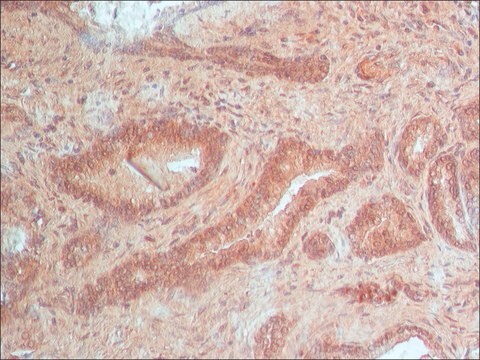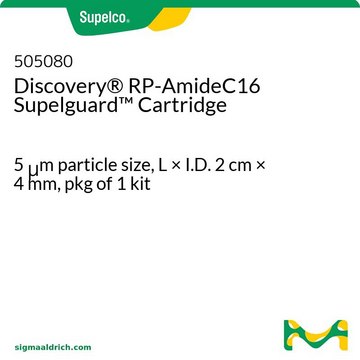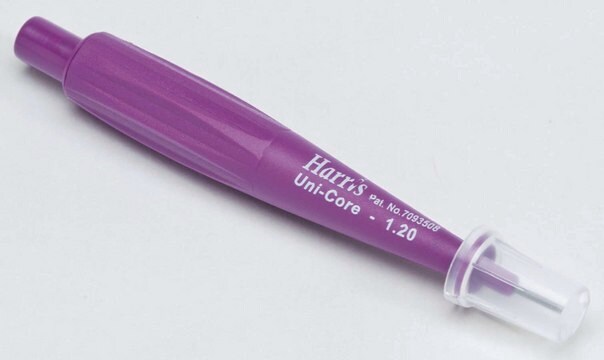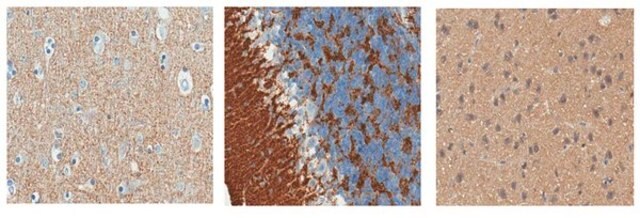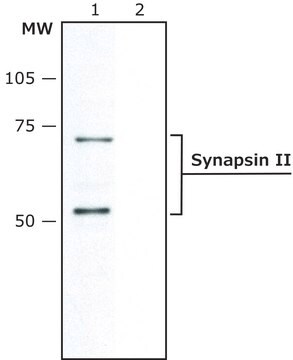MABN1573
Anti-Synapsin-2 Antibody, clone 19.4
clone 19.4, from mouse
Synonym(s):
Synapsin II, Synapsin-2
About This Item
Recommended Products
biological source
mouse
Quality Level
antibody form
purified immunoglobulin
antibody product type
primary antibodies
clone
19.4, monoclonal
species reactivity
rat, mouse, human
technique(s)
activity assay: suitable
immunohistochemistry: suitable (paraffin)
immunoprecipitation (IP): suitable
western blot: suitable
isotype
IgG2aκ
NCBI accession no.
UniProt accession no.
1 of 4
This Item | MABN1584 | S2822 | SAB4502905 |
|---|---|---|---|
| biological source mouse | biological source mouse | biological source rabbit | biological source rabbit |
| antibody form purified immunoglobulin | antibody form purified immunoglobulin | antibody form affinity isolated antibody | antibody form affinity isolated antibody |
| clone 19.4, monoclonal | clone 19.21, monoclonal | clone polyclonal | clone polyclonal |
| species reactivity rat, mouse, human | species reactivity rat, human, mouse | species reactivity mouse, human, rat | species reactivity mouse, rat, human |
| Quality Level 100 | Quality Level 100 | Quality Level 200 | Quality Level - |
General description
Specificity
Immunogen
Application
Western Blotting Analysis: Target detection by a representative lot was blocked by a preincubation with phage particles displaying peptides containing the SYIxN consensus sequence (Vaccaro, P., et al. (1997). Brain Res. Mol. Brain Res. 52(1):1-16).
Western Blotting Analysis: A representative lot detected synapsin IIa/IIb, but not Ia/Ib, in rat brain cytosolic extracts (Vaccaro, P., et al. (1997). Brain Res. Mol. Brain Res. 52(1):1-16).
Immunoprecipitation Analysis: A representative lot immunoprecipitated synapsin IIa/IIb, but not Ia/Ib, from rat brain synaptosomal preparations (Vaccaro, P., et al. (1997). Brain Res. Mol. Brain Res. 52(1):1-16).
Enzyme Assay Analysis: A representative lot, when added 2 hours prior to cAMP, prevented PKA-catalyzed phosphorylation of synapsin IIa/IIb in an in vitro kinase assay using rat brain synaptosomal preparations (Vaccaro, P., et al. (1997). Brain Res. Mol. Brain Res. 52(1):1-16).
Neuroscience
Developmental Neuroscience
Quality
Western Blotting Analysis: 0.5 µg/mL of this antibody detected Synapsin-2 in 10 µg of rat brain tissue lysate.
Target description
Physical form
Storage and Stability
Handling Recommendations: Upon receipt and prior to removing the cap, centrifuge the vial and gently mix the solution. Aliquot into microcentrifuge tubes and store at -20°C. Avoid repeated freeze/thaw cycles, which may damage IgG and affect product performance.
Other Notes
Disclaimer
Not finding the right product?
Try our Product Selector Tool.
Storage Class Code
12 - Non Combustible Liquids
WGK
WGK 2
Flash Point(F)
Not applicable
Flash Point(C)
Not applicable
Certificates of Analysis (COA)
Search for Certificates of Analysis (COA) by entering the products Lot/Batch Number. Lot and Batch Numbers can be found on a product’s label following the words ‘Lot’ or ‘Batch’.
Already Own This Product?
Find documentation for the products that you have recently purchased in the Document Library.
Our team of scientists has experience in all areas of research including Life Science, Material Science, Chemical Synthesis, Chromatography, Analytical and many others.
Contact Technical Service
